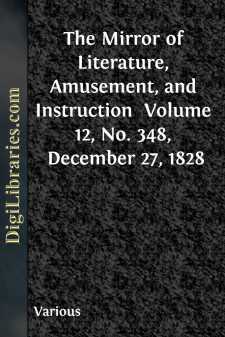Categories
- Antiques & Collectibles 13
- Architecture 36
- Art 48
- Bibles 22
- Biography & Autobiography 813
- Body, Mind & Spirit 142
- Business & Economics 28
- Children's Books 15
- Children's Fiction 12
- Computers 4
- Cooking 94
- Crafts & Hobbies 4
- Drama 346
- Education 46
- Family & Relationships 57
- Fiction 11828
- Games 19
- Gardening 17
- Health & Fitness 34
- History 1377
- House & Home 1
- Humor 147
- Juvenile Fiction 1873
- Juvenile Nonfiction 202
- Language Arts & Disciplines 88
- Law 16
- Literary Collections 686
- Literary Criticism 179
- Mathematics 13
- Medical 41
- Music 40
- Nature 179
- Non-Classifiable 1768
- Performing Arts 7
- Periodicals 1453
- Philosophy 64
- Photography 2
- Poetry 896
- Political Science 203
- Psychology 42
- Reference 154
- Religion 513
- Science 126
- Self-Help 84
- Social Science 81
- Sports & Recreation 34
- Study Aids 3
- Technology & Engineering 59
- Transportation 23
- Travel 463
- True Crime 29
The Mirror of Literature, Amusement, and Instruction Volume 12, No. 348, December 27, 1828
by: Various
Categories:
Description:
Excerpt
Barber's Barn, Hackney.
The engraving represents a place of historical interest—an ancient mansion in Mare-street, Hackney, built about the year 1591, upon a spot of ground called Barbour Berns, by which name, or rather Barber's Barn, the house has been described in old writings.
In this house resided the noted Colonel John Okey, one of the regicides "charged with compassing and imagining the death of the late King Charles I." in October, 1660. Nineteen of these "bold traitors," (among whom was Okey,) fled from justice, and were attainted, and Barber's Barn was in his tenure at the time of his attainder. His interest in the premises being forfeited to the crown, was granted to the Duke of York, who, by his indenture, dated 1663, gave up his right therein to Okey's widow. The colonel was apprehended in Holland, with Sir John Berkestead and Miles Corbett, in 1662, whence they were sent over to England; and having been outlawed for high treason, a rule was made by the Court of King's Bench for their execution at Tyburn. These were the last of the regicides that were punished capitally.
Barber's Barn and its adjoining grounds have, however, since become appropriated to more pacific pursuits than hatching treason, compassing, &c. About the middle of the last century, one John Busch cultivated the premises as a nursery. Catharine II. Empress of Russia, says a correspondent of Mr. Loudon's Gardener's Magazine, "finding she could have nothing done to her mind, she determined to have a person from England to lay out her garden." Busch was the person engaged to go out to Russia for this purpose; and in the year 1771 he gave up his concerns at Hackney, with the nursery and foreign correspondence, to Messrs. Loddidges. These gentlemen, who rank as the most eminent florists and nurserymen of their time, have here extensive green and hot houses which are heated by steam; the ingenious apparatus belonging to which has been principally devised by themselves. Their gardens boast of the finest display of exotics ever assembled in this country, and a walk through them is one of the most delightful spectacles of Nature.
Hackney was once distinguished by princely mansions; but, alas! many of these abodes of wealth have been turned into receptacles for lunatics! Brooke House, formerly the seat of a nobleman of that name, and Balmes' House, within memory surrounded by a moat, and approached only by a drawbridge, have shared this humiliating fate. Sir Robert Viner, who made Charles II. "stay and take t'other bottle," resided here; and John Ward, Esq. M.P. whom Pope has "damned to everlasting fame," had a house at Hackney.
CURIOUS STONE PULPIT.
(For the Mirror.)
The pulpit in the church of St. Peter, at Wolverhampton, is formed wholly of stone. It consists of one entire piece, with the pedestal which supports it, the flight of steps leading to it, with the balustrade, &c., without any division, the whole having been cut out of a solid block of stone. The church was erected in the year 996, at which time it is said this remarkable pulpit was put up; and notwithstanding its great age, which appears to be 832 years, it is still in good condition....












